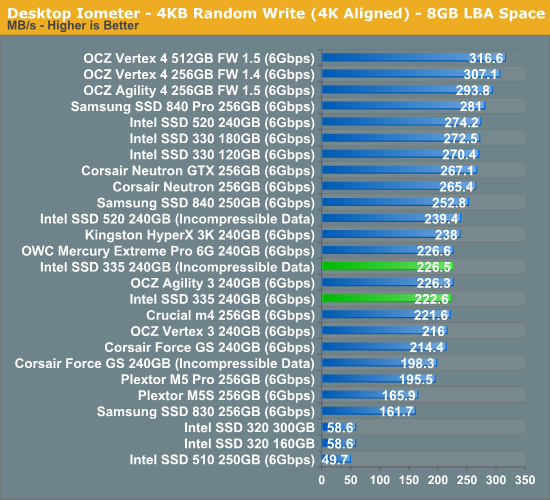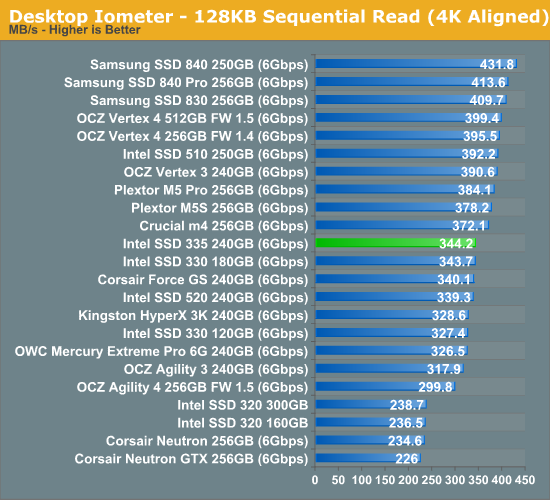Intel SSD 335 (240GB) Review
by Kristian Vättö on October 29, 2012 11:30 AM ESTRandom Read/Write Speed
The four corners of SSD performance are as follows: random read, random write, sequential read and sequential write speed. Random accesses are generally small in size, while sequential accesses tend to be larger and thus we have the four Iometer tests we use in all of our reviews.
Our first test writes 4KB in a completely random pattern over an 8GB space of the drive to simulate the sort of random access that you'd see on an OS drive (even this is more stressful than a normal desktop user would see). I perform three concurrent IOs and run the test for 3 minutes. The results reported are in average MB/s over the entire time. We use both standard pseudo randomly generated data for each write as well as fully random data to show you both the maximum and minimum performance offered by SandForce based drives in these tests. The average performance of SF drives will likely be somewhere in between the two values for each drive you see in the graphs. For an understanding of why this matters, read our original SandForce article.

Random read performance has never been SandForce's biggest strength and even Intel couldn't massively improve it with its own firmware. The SSD 335 is in fact slower than the SSD 330 here.


Random write speed at small queue depths is also slower compared to the 520 and 330, although at queue depth of 32 the difference is negligible.
Sequential Read/Write Speed
To measure sequential performance I ran a 1 minute long 128KB sequential test over the entire span of the drive at a queue depth of 1. The results reported are in average MB/s over the entire test length.


Sequential read performance is identical to SSD 330, but sequential write speed is slightly slower. What's notable is sequential write performance with incompressible data: the Intel SSD 335 manages to beat both the 520 and Corsair's Force GS by a noticeable margin.










69 Comments
View All Comments
Bull Dog - Monday, October 29, 2012 - link
Do you have any hard data to back up this these assertions? Or are they just your unfounded opinions?I ask because the SSD 830 has a terrific reputation for being reliable. It has even demonstrated an exceptionally impressive lifespan over at XtremeSystems Forums.
kkwst2 - Monday, October 29, 2012 - link
Yeah, where's your data on that? I'm not aware of any data that suggests the 830 is less reliable in any way than Crucial or Intel. And my perception from experience and reviews are that Samsung has a significantly better reliability record than Sandforce. All vendors have had firmware issues to some degree, and Intel has had some pretty significant ones. The 8 MB issue on the 320 that caused data loss comes to mind.Samus - Monday, October 29, 2012 - link
Honestly the first Intel SSD I've come across dead was an SSD520 120GB, just wont detect by the system, clearly a Sandforce controller problem.I'd never seen an Intel SSD fail until now that (August 2012) and Intel has made a big mistake joining the likes of OCZ quality with its Sandforce marriage.
JonnyDough - Friday, November 23, 2012 - link
You must forget about all the issues that plague hard drives.MichaelD - Tuesday, October 30, 2012 - link
To what "Samsung drivers" are you referring? You don't need to load any drivers for this or any other SSD (at least in Windows 7, 8 and Server 2012). The driver is provided by Microsoft and has a date of 2006.And I'll note that Samsung SSDs are not plagued by the infamous "Sandforce controller bug." And that Samsung makes the controller the NAND and everything else in the SSD.
So how again, is it less reliable than other SSDs?
centosfan - Wednesday, October 31, 2012 - link
I don't think you know what you are talking about. I have two Samsung 830's and use them everyday and push they quite hard. Haven't had 1 single issue. I haven't heard of any problems with them either.hrga - Thursday, November 1, 2012 - link
It all depends about the market Samsung 830 128GB is here 170USD while 256GB version is 400USD so they aint affordable at all. While Intel 520 series 240GB costs 350USD and 120GB 180USD respectivelyseapeople - Friday, November 2, 2012 - link
So $170 and 128GB is less affordable than $180 and 120GB? You live in strange world.djshortsleeve - Monday, October 29, 2012 - link
I dont see the need for all these various models. Make a value drive and a high end one. You either buy cheapest or best.Kristian Vättö - Monday, October 29, 2012 - link
That's essentially what Intel offers. SSD 335 is the value drive, whereas the successor of SSD 520 will be the high-end one. SSD 335 and 330 are basically the same and 335 will replace the 330 sooner than later (I'm hearing Q1'13 for the other capacities).